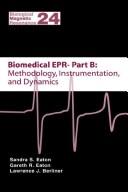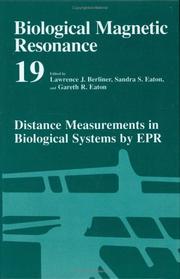| Listing 1 - 5 of 5 |
Sort by
|

ISBN: 0306485060 9780306485567 9786610460205 0306485567 1280460202 0387267417 9781280460203 9780306485565 9780387267418 Year: 2005 Publisher: New York : Kluwer Academic/Plenum Publishers,
Abstract | Keywords | Export | Availability | Bookmark
 Loading...
Loading...Choose an application
- Reference Manager
- EndNote
- RefWorks (Direct export to RefWorks)
Biomedical EPR – Part A focuses on applications of EPR spectroscopy in the areas of free radicals, metals, medicine, and physiology. The book celebrates the 70th birthday of Prof. James S. Hyde, Medical College of Wisconsin, and his contributions to this field. Chapters are written to provide introductory material for new-comers to the field which lead into up-to-date reviews that provide perspective on the wide range of questions that can be addressed by EPR. Key Features: Free Radicals in Medicine Radicals in vivo and in Model Systems, and their Study by Spin Trapping In vivo EPR, including Oximetry and Imaging Time Domain EPR at Radio Frequencies EPR of Copper Complexes: Motion and Frequency Dependence Time Domain EPR and Electron Spin Echo Envelope Modulation About the Editors: Prof. Sandra S. Eaton is John Evans Professor in the Department of Chemistry and Biochemistry at the University of Denver. Her research interests include distance measurements in proteins, EPR of metal ions in biological systems, electron spin relaxation times, and EPR instrumentation. The Eatons co-organize an annual EPR Symposium in Denver. Prof. Gareth R. Eaton is John Evans Professor in the Department of Chemistry and Biochemistry at the University of Denver. His research interests include EPR instrumentation, distance measurements in proteins, EPR of metal ions in biological systems, and electron spin relaxation times. Dr. Lawrence J. Berliner is currently Professor and Chair of the Department of Chemistry and Biochemistry at the University of Denver after retiring from Ohio State University, where he spent a 32-year career in the area of biological magnetic resonance (EPR and NMR). He is the Series Editor for Biological Magnetic Resonance, which he launched in 1979.
Electron paramagnetic resonance spectroscopy. --- Medicine --- Biology --- Health & Biological Sciences --- Radiology, MRI, Ultrasonography & Medical Physics --- Biology - General --- Spectrum analysis. --- Analysis, Spectrum --- Spectra --- Spectrochemical analysis --- Spectrochemistry --- Spectroscopy --- Electron spin resonance spectroscopy --- EPR spectroscopy --- ESR spectroscopy --- Chemistry, Analytic --- Interferometry --- Optics --- Radiation --- Wave-motion, Theory of --- Absorption spectra --- Light --- Spectroscope --- Spectrum analysis --- Qualitative --- Spectrometry --- Analytical chemistry

ISBN: 030648532X 1441934588 9786610413669 1280413662 0306485338 Year: 2005 Publisher: New York : Kluwer Academic/Plenum Publishers,
Abstract | Keywords | Export | Availability | Bookmark
 Loading...
Loading...Choose an application
- Reference Manager
- EndNote
- RefWorks (Direct export to RefWorks)
Biomedical EPR – Part B focuses on applications of EPR techniques and instrumentation, with applications to dynamics. The book celebrates the 70th birthday of Prof. James S. Hyde, Medical College of Wisconsin, and his contributions to this field. Chapters are written to provide introductory material for new-comers to the field that lead into up-to-date reviews that provide perspective on the wide range of questions that can be addressed by EPR. Key Features: EPR Techniques including Saturation Recovery, ENDOR, ELDOR, and Saturation Transfer Instrumentation Innovations including Loop Gap Resonators, Rapid Mixing, and Time Locked Sub-Sampling Motion in Biological Membranes Applications to Structure Determination in Proteins Discussion of Trends in EPR Technology and Prognosis for the Future About the Editors: Prof. Sandra S. Eaton is John Evans Professor in the Department of Chemistry and Biochemistry at the University of Denver. Her research interests include distance measurements in proteins, EPR of metal ions in biological systems, electron spin relaxation times, and EPR instrumentation. The Eatons co-organize an annual EPR Symposium in Denver. Prof. Gareth R. Eaton is John Evans Professor in the Department of Chemistry and Biochemistry at the University of Denver. His research interests include EPR instrumentation, distance measurements in proteins, EPR of metal ions in biological systems, and electron spin relaxation times. Dr. Lawrence J. Berliner is currently Professor and Chair of the Department of Chemistry and Biochemistry at the University of Denver after retiring from Ohio State University, where he spent a 32-year career in the area of biological magnetic resonance (EPR and NMR). He is the Series Editor for Biological Magnetic Resonance, which he launched in 1979.
Electron paramagnetic resonance spectroscopy. --- Human Anatomy & Physiology --- Biology --- Medicine --- Health & Biological Sciences --- Animal Biochemistry --- Radiology, MRI, Ultrasonography & Medical Physics --- Biology - General --- Spectrum analysis. --- Analysis, Spectrum --- Spectra --- Spectrochemical analysis --- Spectrochemistry --- Spectroscopy --- Electron spin resonance spectroscopy --- EPR spectroscopy --- ESR spectroscopy --- Radiology, Medical. --- Biochemistry. --- Chemistry, Physical organic. --- Imaging / Radiology. --- Biochemistry, general. --- Biological and Medical Physics, Biophysics. --- Atomic, Molecular, Optical and Plasma Physics. --- Physical Chemistry. --- Chemistry, Analytic --- Interferometry --- Optics --- Radiation --- Wave-motion, Theory of --- Absorption spectra --- Light --- Spectroscope --- Spectrum analysis --- Qualitative --- Chemistry, Physical organic --- Chemistry, Organic --- Chemistry, Physical and theoretical --- Biological chemistry --- Chemical composition of organisms --- Organisms --- Physiological chemistry --- Chemistry --- Medical sciences --- Clinical radiology --- Radiology, Medical --- Radiology (Medicine) --- Medical physics --- Composition --- Radiology. --- Biophysics. --- Biological physics. --- Atoms. --- Physics. --- Physical chemistry. --- Chemistry, Theoretical --- Physical chemistry --- Theoretical chemistry --- Natural philosophy --- Philosophy, Natural --- Physical sciences --- Dynamics --- Matter --- Stereochemistry --- Biological physics --- Physics --- Radiological physics --- Constitution

ISBN: 0306465337 1475705751 0306471094 Year: 2000 Publisher: New York Kluwer
Abstract | Keywords | Export | Availability | Bookmark
 Loading...
Loading...Choose an application
- Reference Manager
- EndNote
- RefWorks (Direct export to RefWorks)
Distance measurements in biological systems by EPR The foundation for understanding function and dynamics of biological systems is knowledge of their structure. Many experimental methodologies are used for determination of structure, each with special utility. Volumes in this series on Biological Magnetic Resonance emphasize the methods that involve magnetic resonance. This volume seeks to provide a critical evaluation of EPR methods for determining the distances between two unpaired electrons. The editors invited the authors to make this a very practical book, with specific numerical examples of how experimental data is worked up to produce a distance estimate, and realistic assessments of uncertainties and of the range of applicability, along with examples of the power of the technique to answer biological problems. The first chapter is an overview, by two of the editors, of EPR methods to determine distances, with a focus on the range of applicability. The next chapter, also by the Batons, reviews what is known about electron spin relaxation times that are needed in estimating distances between spins or in selecting appropriate temperatures for particular experiments. Albert Beth and Eric Hustedt describe the information about spin-spin interaction that one can obtain by simulating CW EPR line shapes of nitroxyl radicals. The information in fluid solution CW EPR spectra of dual-spin labeled proteins is illustrated by Hassane Mchaourab and Eduardo Perozo.
Theoretical spectroscopy. Spectroscopic techniques --- fysicochemie --- Organic spectroscopy --- Magnetic resonance. --- Radiology, Medical. --- Biochemistry. --- Chemistry, Physical organic. --- Imaging / Radiology. --- Biochemistry, general. --- Biological and Medical Physics, Biophysics. --- Atomic, Molecular, Optical and Plasma Physics. --- Physical Chemistry. --- Electron paramagnetic resonance. --- Radiology. --- Biophysics. --- Biological physics. --- Atoms. --- Physics. --- Physical chemistry. --- Chemistry, Theoretical --- Physical chemistry --- Theoretical chemistry --- Chemistry --- Natural philosophy --- Philosophy, Natural --- Physical sciences --- Dynamics --- Chemistry, Physical and theoretical --- Matter --- Stereochemistry --- Biological physics --- Biology --- Medical sciences --- Physics --- Biological chemistry --- Chemical composition of organisms --- Organisms --- Physiological chemistry --- Radiological physics --- Radiation --- Constitution --- Composition --- Resonance, Magnetic --- Atoms --- Magnetic fields --- Nuclear spin --- Electron resonance --- Electron spin resonance --- EPR (Magnetic resonance) --- ESR (Magnetic resonance) --- Paramagnetic resonance, Electron --- Magnetic resonance --- Paramagnetism
Book
ISBN: 9783211929483 9783211938898 9783709116814 9783211929476 Year: 2010 Publisher: Vienna Springer Vienna Imprint Springer
Abstract | Keywords | Export | Availability | Bookmark
 Loading...
Loading...Choose an application
- Reference Manager
- EndNote
- RefWorks (Direct export to RefWorks)
This is the first comprehensive yet practical guide for people who perform quantitative EPR measurements. No existing book provides this level of practical guidance to ensure the successful use of EPR. There is a growing need in both industrial and academic research to provide meaningful and accurate quantitative EPR results. This text discusses the various sample, instrument and software related aspects required for EPR quantitation. Specific topics include: choosing a reference standard, resonator considerations (Q, B1, Bm), power saturation characteristics, sample positioning, and finally, putting all the factors together to obtain an accurate spin concentration of a sample.
Physicochemistry --- Chemical structure --- Chemistry --- General biochemistry --- Molecular biology --- General biophysics --- Materials sciences --- Food science and technology --- spectra (chemie) --- moleculaire structuur --- materiaalkennis --- biofysica --- voedingschemie --- biochemie --- chemie --- fysicochemie --- atoomstructuur
Multi
ISBN: 9783211929483 9783211938898 9783709116814 9783211929476 Year: 2010 Publisher: Vienna Springer
Abstract | Keywords | Export | Availability | Bookmark
 Loading...
Loading...Choose an application
- Reference Manager
- EndNote
- RefWorks (Direct export to RefWorks)
This is the first comprehensive yet practical guide for people who perform quantitative EPR measurements. No existing book provides this level of practical guidance to ensure the successful use of EPR. There is a growing need in both industrial and academic research to provide meaningful and accurate quantitative EPR results. This text discusses the various sample, instrument and software related aspects required for EPR quantitation. Specific topics include: choosing a reference standard, resonator considerations (Q, B1, Bm), power saturation characteristics, sample positioning, and finally, putting all the factors together to obtain an accurate spin concentration of a sample.
Physicochemistry --- Chemical structure --- Chemistry --- General biochemistry --- Molecular biology --- General biophysics --- Materials sciences --- Food science and technology --- spectra (chemie) --- moleculaire structuur --- materiaalkennis --- biofysica --- voedingschemie --- biochemie --- chemie --- fysicochemie --- atoomstructuur
| Listing 1 - 5 of 5 |
Sort by
|

 Search
Search Feedback
Feedback About UniCat
About UniCat  Help
Help News
News